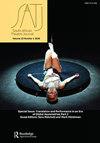The L1–L2 tension in performance: towards prosodic explorations to facilitate intent
IF 0.2
0 THEATER
引用次数: 0
Abstract
This article tackles the issue of working in theatrical performance across multiple languages. More specifically, it documents and theorizes explorations conducted to attempt to bridge potential interpretation and communication disjunctures that might arise as actors who have a specific first language (L1) work in performance in a second/other language to which they have semantic/literal access but might not have the nuanced, multivalent and embodied access that is required to ‘present text in performance convincingly’ from their L2 situation [An argument can be made that when L1 texts are presented by L2 speakers to other L2 speakers, the problem falls away. For the purposes of this article, the emphasis is placed on presenting the L1 text as it might have been envisaged (noting the problems around such a stance).]. Such a multicultural/multilingual situation is prevalent in the South African tertiary training classroom, where it is usual to find that only a small minority have L1 access to English (for example) – the language of instruction. The article, therefore attempts ways of bridging this L1 (first language)/L2 (performance language) divide in training using the notion of prosody as the bridging strategy. Although our explorations worked with English, it is posited that the L1/L2 divide occurs in many societies, and therefore our conclusions and suggests we extrapolate would be of assistance in those domains, too.演奏中的L1-L2张力:朝向有利于意图的韵律探索
这篇文章讨论了跨语言的戏剧表演工作的问题。更具体地说,它记录并理论化了试图弥合潜在的解释和沟通障碍的探索,这些障碍可能出现在拥有特定第一语言(L1)的演员用第二语言/其他语言进行表演时,他们有语义/文字访问,但可能没有细微差别。从他们的第二语言情境中“令人信服地呈现文本”所需要的多价值和具体化的访问[可以提出一个论点,当母语文本由第二语言说话者呈现给其他第二语言说话者时,问题就消失了。出于本文的目的,重点放在按照可能设想的方式呈现L1文本(注意围绕这种立场的问题)。这种多元文化/多语言的情况在南非的高等教育课堂中很普遍,在那里通常发现只有少数人能够使用英语(例如)作为教学语言。因此,本文试图利用韵律的概念作为桥梁策略,在训练中弥合L1(第一语言)/L2(表演语言)的鸿沟。尽管我们的研究针对的是英语,但我们假设在许多社会中都存在母语/第二语言的差异,因此我们的结论和推断也会对这些领域有所帮助。
本文章由计算机程序翻译,如有差异,请以英文原文为准。
求助全文
约1分钟内获得全文
求助全文

 求助内容:
求助内容: 应助结果提醒方式:
应助结果提醒方式:


